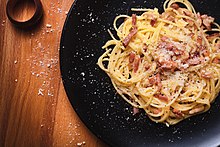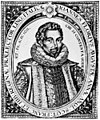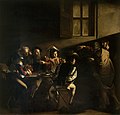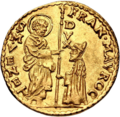The Italy portal
Italy Italian Republic , is a country in Southern and Western Europe. It is located on a peninsula that extends into the middle of the Mediterranean Sea , with the Alps on its northern land border, as well as islands, notably Sicily and Sardinia. Italy shares its borders with France, Switzerland, Austria, Slovenia and two enclaves: Vatican City and San Marino . It is the tenth-largest country in the Europe, covering an area of 301,340 km2 (116,350 sq mi), and third-most populous member state of the European Union , with a population of nearly 60 million. Its capital and largest city is Rome ; other major urban areas include Milan , Naples , Turin , Florence , and Venice .
In antiquity, the Italian peninsula was home to numerous peoples ; the Latin city of Rome, founded as a Kingdom , became a Republic that conquered the Mediterranean world and ruled it for centuries as an Empire . With the spread of Christianity, Rome became the seat of the Catholic Church and the Papacy . During the Early Middle Ages , Italy experienced the fall of the Western Roman Empire and inward migration from Germanic tribes. By the 11th century, Italian city-states and maritime republics expanded, bringing renewed prosperity through commerce and laying the groundwork for modern capitalism. The Italian Renaissance flourished during the 15th and 16th centuries and spread to the rest of Europe. Italian explorers discovered new routes to the Far East and the New World , leading the European Age of Discovery . However, centuries of rivalry and infighting between city-states left the peninsula divided . During the 17th and 18th centuries , Italian economic importance waned significantly. (Full article...
The Italian Renaissance Italian : Rinascimento [rinaʃʃiˈmento] Italian history covering the 15th and 16th centuries . The period is known for the initial development of the broader Renaissance culture that spread across Western Europe and marked the transition from the Middle Ages to modernity . Proponents of a "long Renaissance" argue that it started around the year 1300 and lasted until about 1600. In some fields, a Proto-Renaissance , beginning around 1250, is typically accepted. The French word renaissance (corresponding to rinascimento in Italian) means "rebirth", and defines the period as one of cultural revival and renewed interest in classical antiquity after the centuries during what Renaissance humanists labelled as the "Dark Ages" . The Italian Renaissance historian Giorgio Vasari used the term rinascita ("rebirth") in his Lives of the Most Excellent Painters, Sculptors, and Architects Jules Michelet and Jacob Burckhardt .
The Renaissance began in
Tuscany in
Central Italy and centred in the city of
Florence . The
Florentine Republic , one of the several
city-states of the
peninsula , rose to economic and political prominence by providing credit for
European monarchs and by laying down the groundwork for developments in
capitalism and in
banking . Renaissance culture later spread to
Venice , the heart of a
Mediterranean empire and in control of the trade routes with the east since its participation in the
Crusades and following the journeys of
Marco Polo between 1271 and 1295. Thus Italy renewed contact with the remains of
ancient Greek culture , which provided humanist scholars with new texts. Finally the Renaissance had a significant effect on the
Papal States and on
Rome , largely rebuilt by
humanist and
Renaissance popes , such as
Julius II (
r. 1503–1513) and
Leo X (
r. 1513–1521), who frequently became involved in
Italian politics , in
arbitrating disputes between competing colonial powers and in
opposing the
Protestant Reformation , which started
c. 1517 . (
Full article... )
List of selected articles
Carbonara Italian: [karboˈnaːra] pasta dish made with fatty cured pork, eggs, hard cheese , salt, and black pepper. It is typical of the Lazio region of Italy . The dish took its modern form and name in the middle of the 20th century.
The cheese is usually
pecorino romano . Some variations use
Parmesan ,
Grana Padano , or a combination of cheeses.
Spaghetti is the most common pasta, but
rigatoni or
bucatini are also used. While
guanciale , a cured pork
jowl , is traditional, some variations use
pancetta , and
lardons of smoked
bacon are a common substitute outside Italy. (
Full article... )
List of fare/cuisine articles
Category puzzle Select [►] to view subcategories
The following are images from various Italy-related articles on Wikipedia.
Image 2 Alessandro Manzoni is famous for the novel
The Betrothed (1827), generally ranked among the masterpieces of
world literature . (from
Culture of Italy )
Image 3 The Last Supper by Leonardo da Vinci, possibly one of the most famous and iconic examples of
Italian art (from
Culture of Italy )
Image 4 Entrance to
Cinecittà in Rome, the largest film studio in
Europe (from
Culture of Italy )
Image 5 William Shakespeare is an example of an Italophile of the 16th century. (from
Culture of Italy )
Image 6 The
Venice Film Festival is the oldest film festival in the world. (from
Culture of Italy )
Image 8 Traditional
pizza Margherita , whose ingredients,
tomato (red),
mozzarella (white) and
basil (green), are inspired by the colours of the national
flag of Italy . (from
Culture of Italy )
Image 10 The
Forum of
Pompeii with
Vesuvius in the distance (from
Culture of Italy )
Image 14 Sandro Botticelli ,
The Birth of Venus (c. 1486).
Tempera on canvas. 172.5 cm × 278.9 cm (67.9 in × 109.6 in).
Uffizi , Florence. (from
Culture of Italy )
Image 15 Scrovegni Chapel . The chapel contains a
fresco cycle by
Giotto , completed about 1305 and considered to be an important masterpiece of
Western art . (from
Culture of Italy )
Image 16 Palazzo Senatorio , seat of the municipality of
Rome . It has been a
town hall since AD 1144, making it the oldest town hall in the world. (from
Culture of Italy )
Image 18 The
espresso comes from the Italian
esprimere, which means "to express," and refers to the process by which hot water is forced under pressure through ground coffee. (from
Culture of Italy )
Image 20 The Creation of Adam is one of the scenes on the ceiling of the
Sistine Chapel of the Vatican, painted by Michelangelo sometime between 1508 and 1512. (from
Culture of Italy )
Image 21 Gelato is Italian ice cream. (from
Culture of Italy )
Image 22 The cover of the
Corriere dei Piccoli on 11 July 1911 carries a cartoon strip in the Italian style without speech bubbles. (from
Culture of Italy )
Image 25 The
Jefferson Memorial in
Washington, D.C. , reflects the president's admiration for classical Roman aesthetics (from
Culture of Italy )
Image 28 Leonardo da Vinci 's
Mona Lisa is an Italian art masterpiece worldwide famous. (from
Culture of Italy )
Image 29 The
Sagra dell'uva in
Marino , celebrating grapes (from
Culture of Italy )
Image 30 Dario Fo , one of the most widely performed playwrights in modern theatre, received international acclaim for his highly
improvisational style. He was awarded the
Nobel Prize for Literature in 1997. (from
Culture of Italy )
Image 31 Federico Fellini , considered one of the most influential and widely revered
filmmakers in the history of cinema (from
Culture of Italy )
Image 34 A wooden puppet depicting the
Befana (from
Culture of Italy )
Image 35 Palazzo della Civiltà Italiana in Rome is a perfect example of modern Italian architecture. (from
Culture of Italy )
Image 36 Romulus and Remus , the
Lupercal ,
Father Tiber , and the
Palatine on a
relief from a pedestal dating to the reign of
Trajan (AD 98–117) (from
Culture of Italy )
Image 39 Pietà , by
Michelangelo is a key work of Italian Renaissance sculpture. (from
Culture of Italy )
Image 41 The
Colosseum , originally known as the Flavian Amphitheatre, is an elliptical amphitheatre in the centre of the city of Rome, the largest ever built in the Roman Empire. (from
Culture of Italy )
Image 43 David , by
Michelangelo (
Accademia di Belle Arti ,
Florence , Italy) is a masterpiece of Renaissance and world art. (from
Culture of Italy )
Image 44 Dante Alighieri , one of the greatest poets of the
Middle Ages . His epic poem
The Divine Comedy ranks among the finest works of
world literature . (from
Culture of Italy )
Image 46 John Florio is recognised as the most important Renaissance humanist in England (from
Culture of Italy )
Image 47 Ferragosto fireworks display in
Padua on 15 August 2010 (from
Culture of Italy )
Image 48 The
Roman Empire provided an inspiration for the medieval European. Although the
Holy Roman Empire rarely acquired a serious geopolitical reality, it possessed great symbolic significance. (from
Culture of Italy )
Image 50 Royal Palace of Caserta , the largest royal residence in the world (from
Culture of Italy )
Image 51 The historic seat of the
Corriere della Sera in via Solferino in
Milan (from
Culture of Italy )
Image 53 The
Altare della Patria in Rome, a
national symbol of Italy celebrating the first king of the unified country, and resting place of the
Italian Unknown Soldier since the end of World War I. It was inaugurated in 1911, on the occasion of the 50th
Anniversary of the Unification of Italy . (from
Culture of Italy )
Image 54 Clockwise from top left:
Thomas Aquinas , proponent of natural theology and the Father of
Thomism ;
Giordano Bruno , one of the major scientific figures of the Western world;
Cesare Beccaria , considered the Father of criminal justice and modern criminal law; and
Maria Montessori , credited with the creation of the
Montessori education (from
Culture of Italy )
Image 56 Antonio Vivaldi , in 1723. His best-known work is a series of
violin concertos known as
The Four Seasons . (from
Culture of Italy )
Image 57 Giorgio Moroder , pioneer of
Italo disco and
electronic dance music , is known as the "Father of disco". (from
Culture of Italy )
Image 58 Regional seat of
RAI in Cosenza (from
Culture of Italy )
Image 60 Teatro di San Carlo ,
Naples . It is the oldest continuously active venue for opera in the world. (from
Culture of Italy )
Image 61 Luciano Pavarotti , considered one of the finest tenors of the 20th century and the "King of the
High Cs " (from
Culture of Italy )
Image 63 Folkloristic reconstruction of the
Company of Death led by
Alberto da Giussano who is preparing to carry out the
charge during the
battle of Legnano at the
Palio di Legnano 2014 (from
Culture of Italy )
Articles related to Italy
Astronomical observatories in Italy
Automobile museums in Italy
Central bank Public banks Global banks Nationwide and Multi-regional Multi-regional and Co-operative banks (BCC) Regional retail bank others Foreign banks Ancient banks Related topics
Historical minority communities Ethno-linguistic minorities Scattered minorities
Historic currency and coinage of Italy
Overview Ancient Medieval Modern Contemporary
Africa Americas Asia Europe Oceania Exodus Neighborhoods Other
1890s-1950s 1960s-1980s Other
Historical linguistic minorities :
Albanian ,
Catalan ,
Croatian ,
French ,
Franco-Provençal ,
Friulian ,
Germanic ,
Greek ,
Ladin ,
Occitan ,
Romani ,
Sardinian ,
Slovene ,
Wenzhounese
^ Venetian is either grouped with the rest of the Italo-Dalmatian or the Gallo-Italic languages, depending on the linguist.
National Regional/local Financial Sports Free On-line
Resources in Italy
Oil Natural gas
Kingdom of Sardinia (1720–1861)
Prima Triennale Pubblica Esposizione dell’anno (1829)
Seconda Triennale Pubblica Esposizione dell’anno (1832)
Pubblica esposizione dell'anno (1838)
Quarto Esposizione d'Industria et di Belle Arti (1844)
Esposizione dei Prodotti e delle Manufatture nazionale (1846)
Quinta Esposizione di Industria e di Belle Arti (1850)
Esposizione Industriale (1854)
Sesta Esposizione Nazionale di Prodotti d'Industria Kingdom of the Two Sicilies (1808–1861)
Solenne Pubblica Esposizione di Arti e Manifatture (1853) Kingdom of Italy (1861–1946)Italy (1946 - present)









































































































